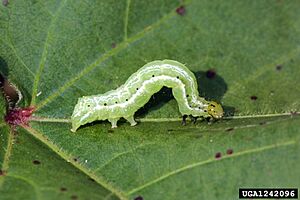Soybean looper facts for kids
Quick facts for kids Soybean looper |
|
|---|---|
 |
|
| Scientific classification | |
| Kingdom: | |
| Phylum: | |
| Class: | |
| Order: | |
| Family: | |
| Genus: |
Chrysodeixis
|
| Species: |
C. includens
|
| Binomial name | |
| Chrysodeixis includens (Walker, 1858)
|
|
| Synonyms | |
|
|
The soybean looper (Chrysodeixis includens) is a type of moth from the Noctuidae family. You might hear it called falso medidor in parts of Mexico. These moths can be found in many places, from southern Quebec and Ontario in Canada, all the way through the eastern and southern United States, down to Central America, South America, the Antilles, and even the Galápagos Islands. They are known to travel long distances, which means they are migratory. This moth was first officially described by a scientist named Francis Walker in 1858.
Contents
What Does the Soybean Looper Look Like?
The soybean looper moth has a wingspan that measures between 28 and 39 millimeters. That's about 1.1 to 1.5 inches wide! Adult moths are usually seen flying from April to November, but this can change depending on where they live.
Life Cycle and What They Eat
The young soybean loopers, called larvae or caterpillars, eat a wide variety of plants. They are not picky eaters! Some of the plants they are known to feed on include:
- Plants from the Asteraceae family (like daisies and sunflowers)
- Brassicaceae family (like cabbage and broccoli)
- Commelinaceae family
- Euphorbiaceae family
- Fabaceae family (like beans and peas)
- Geraniaceae family
- Lamiaceae family
- Lauraceae family (like laurel)
- Malvaceae family
- Solanaceae family (like tomatoes and potatoes)
- Verbenaceae family
They also enjoy specific plants such as alfalfa (Medicago sativa), Phaseolus polystachios, soybeans (Glycine max), Gossypium herbaceum, Nicotiana tabacum, tomatoes (Lycopersicum esculentum), Brassica plants, and lettuce (Lactuca sativa).
Who Eats the Soybean Looper?
The soybean looper is a food source for other animals. For example, the Mexican free-tailed bat (Tadarida brasiliensis) is known to hunt and eat these moths.
See also
 In Spanish: Chrysodeixis includens para niños
In Spanish: Chrysodeixis includens para niños


